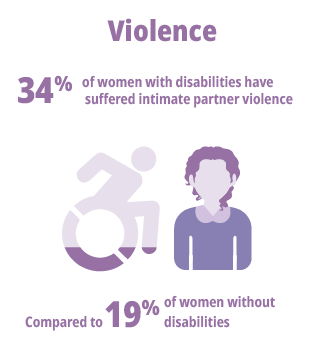Inequalities heighten the risk of violence against women
While violence affects all women, some groups face a higher risk (EIGE, 2020a). The 2019 Fundamental Rights Survey (FRA, 2021) revealed higher harassment rates in the preceding 5 years among specific groups. These include women self-identifying as lesbian, bisexual or ‘other’ (57 %); women not citizens of where they live (51 %); women educated to tertiary level (49 %); and women with disabilities hampering their ability to take part in common activities (48 %).

The violence against women survey (FRA, 2014) also showed that disability substantially increases women’s vulnerability to violence, especially from a close or intimate partner. About a third of women with disabilities (34 %) suffered intimate partner violence, compared with 19 % of women without a disability. Yet women with disabilities are usually missing from strategies to combat violence against women, and often are physically unable to access shelters and other facilities, forcing them to remain in violent situations (Mandl et al., 2014).
Increased social media use and digital technology advances have seen an upsurge in online harassment and abuse, particularly against young women and girls. In the EU, 13 % of women have overall experienced cyber-harassment. Among 16- to 29-year-olds, it is more prevalent, at 25 % (FRA, 2021). Consequently, girls and young women (aged 15–18 years) considerably restrict what they express online for fear of harassment, gossip and hateful comments (EIGE, 2019a).
Eventually such violence can silence women and discourage them from taking a prominent role in public life. For example, about 4 out of 10 journalists have reported self-censorship following online abuse (EIGE, 2020a). Many women in public roles, especially those fighting for the rights of women and minorities (politicians, lawyers, activists, etc.), are victims of gender-based cyber-harassment (European Parliament, 2018, 2021).
Since 2012, EIGE has been mapping the prevalence of FGM in the EU by estimating the number of women and girls (aged 0–18 years) at risk of FGM and identifying good practices to tackle it. The most recent assessment, carried out in Denmark, Spain, Luxembourg and Austria[1], shows that the risk of FGM is less pronounced when a woman or girl is in the EU (EIGE, 2021b). However, the risk increases when unmarried girls and women return to their country of origin. In Denmark, Luxembourg and Austria, girl asylum seekers are at a higher estimated risk of FGM than the general migrant population.
This highlights the importance of having gender-sensitive asylum procedures in place to prevent FGM and protect girls at risk, and to help women and girls who have undergone FGM (EIGE, 2021b). The study also demonstrates the need to strengthen sensitivity to intersecting inequalities, including through culturally sensitive approaches in sexual and reproductive healthcare systems (see Section 9.2.1.).
FRA’s second LGBTI survey, conducted in 2019 (FRA, 2020b), found that 1 in 10 lesbian women (10 %) in the EU-27 were physically or sexually attacked in the 5 years before the survey because of their sexual orientation. FRA’s second LGBTI survey, conducted in 2019 (FRA, 2020b), found that 1 in 10 lesbian women (10 %) in the EU-27 were physically or sexually attacked in the 5 years before the survey because of their sexual orientation.
Prevalence ranged from 16 % in Croatia to 3 % in Portugal. Only 16 % of lesbian women reported the most recent hate-motivated physical and sexual attack to any organisation, including the police. This was mostly because of fear of homophobic reaction.
Harassment[2] is the most widespread form of violence against lesbian women, with 56 % experiencing in-person harassment for any reason in the previous 5 years and 11 % suffering cyber-harassment over the same time frame. In the 12 months before the survey, 48 % of lesbian women were harassed for any reason and 40 % were harassed because of their sexual orientation.
Prevalence rates vary from 52 % in Latvia, 50 % in Lithuania and 48 % in Belgium to 22 % in Cyprus and 28 % in Malta and Portugal. Of the most recent incidents of hate-motivated harassment against this group, 71 % were perpetrated by men. In 62 % of cases, the perpetrator was unknown to the woman (FRA, 2020b)[3].